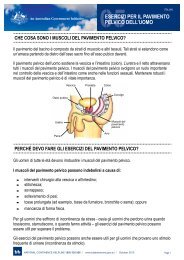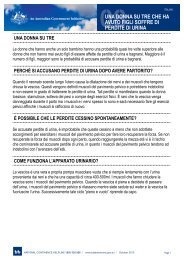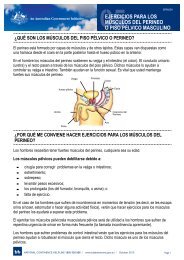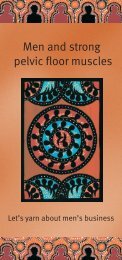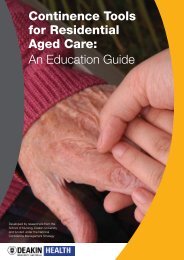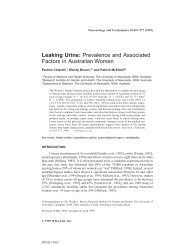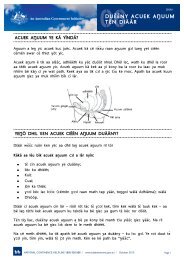Pharmacy Continence Care - Bladder and Bowel Website
Pharmacy Continence Care - Bladder and Bowel Website
Pharmacy Continence Care - Bladder and Bowel Website
Create successful ePaper yourself
Turn your PDF publications into a flip-book with our unique Google optimized e-Paper software.
4 OUTCOMES AND EFFECTIVENESS EVALUATION<br />
4.1 Introduction<br />
The evaluation strategy for this pilot Program aims to measure cost <strong>and</strong> benefits to<br />
consumers <strong>and</strong> pharmacies <strong>and</strong> the cost-effectiveness <strong>and</strong> sustainability of the Program.<br />
At the outset of the project, the project team consulted with the Expert Advisory Group <strong>and</strong><br />
the NOVA Expert Panel on validated or appropriate methods for measuring:<br />
• business benefit <strong>and</strong> costs to pharmacists<br />
• health gains <strong>and</strong> costs for consumers<br />
• referrals to, <strong>and</strong> consumer take-up of, other health services.<br />
The initial project design proposed:<br />
• the testing, on a beta sample of pharmacists, of measures appropriate to identify<br />
o pharmacy benefits, particularly:<br />
▪ spending on incontinence <strong>and</strong> other products (turnover)<br />
▪ evidence of increased customer loyalty (visits/customer)<br />
▪ improved profile of pharmacy in community (yes/no?)<br />
▪ responses to provision of pharmacological advice<br />
▪ responses to referral to other health professionals<br />
o costs to pharmacists such as:<br />
▪ extra time serving customers, attending training (hours)<br />
▪ increased stock of information materials <strong>and</strong> products ($)<br />
▪ assess provision of ongoing support/management<br />
• testing with a selected sample of consumers of a benefit/outcomes baseline survey <strong>and</strong><br />
follow-up survey to identify:<br />
o product consumption, contact with health professional/s<br />
o effect on mobility/social activities<br />
o effect on awareness/control of incontinence<br />
o effect on quality of life/satisfaction.<br />
In the light of the consultation strategy with consumer organisations, <strong>and</strong> following<br />
consultation with the NOVA Expert Panel, the project team determined that beta samples of<br />
pharmacists <strong>and</strong> consumers were not possible in the time available to the project, nor<br />
essential to the testing of the evaluation tools. The NOVA Expert Panel has been closely<br />
involved in the development <strong>and</strong> review of evaluation measures, <strong>and</strong> the consumer strategy<br />
in particular is based on an internationally validated <strong>and</strong> reliable measure of incontinence<br />
impact on health <strong>and</strong> wellbeing.<br />
In meetings in September <strong>and</strong> November 2004, the NOVA Expert Panel <strong>and</strong> the project team<br />
met to discuss the evaluation requirements for this project. The group determined that:<br />
• to evaluate pharmacy benefits, a semi-structured two-stage telephone survey of the<br />
participating pharmacies (≈50) was appropriate, with a baseline instrument administered<br />
Final Report<br />
21<br />
NOVA Public Policy<br />
<strong>Pharmacy</strong> <strong>Continence</strong> <strong>Care</strong> Project



